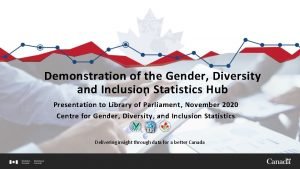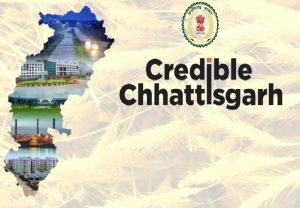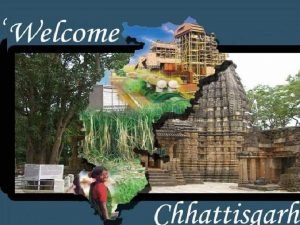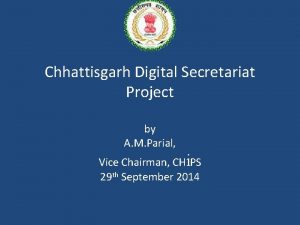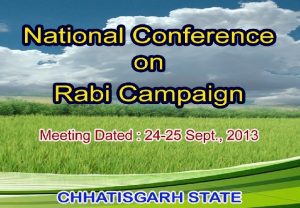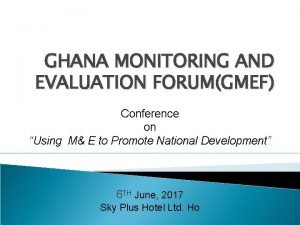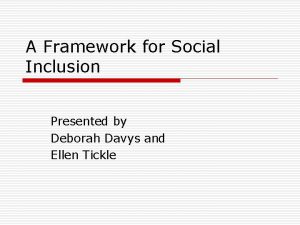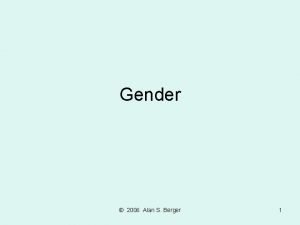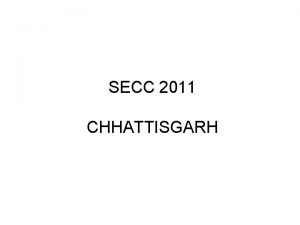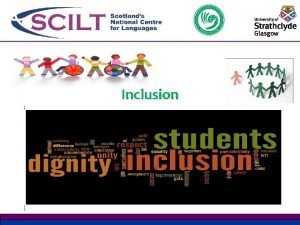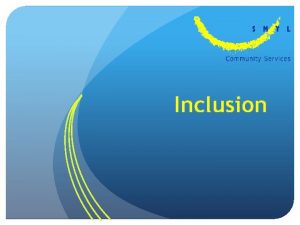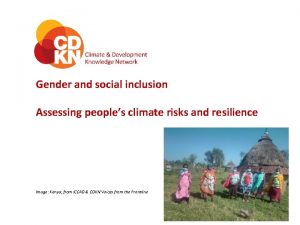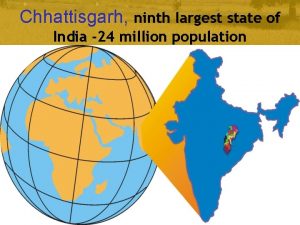CHHATTISGARH STATE GENDER AND SOCIAL INCLUSION FOR CLIMATE











- Slides: 11

CHHATTISGARH STATE GENDER AND SOCIAL INCLUSION FOR CLIMATE PROOFING GROWTH & DEVELOPMENT

Background ◦ Total population of Chhattisgarh (CG) as per 2011 census is 25, 545, 198 of which male and female are 12, 832, 895 and 12, 712, 303 respectively. ◦ 39. 93% people live Below the Poverty Line (BPL)considered the poorest state in India. ◦ 33% population of Scheduled Tribes (Indigenous Communities) and 12% Scheduled Castes (disadvantaged mostly Dalits) ◦ 50% of the villages lie within 5 km radius of forest, where inhabitants are mainly tribal and economically backward whose livelihoods depend mainly on forests. ◦ While rainfall in the JJAS (monsoon) period is good, every third year CG faces a drought. Agricultural vulnerability is high.

Chhattisgarh Agro Climatic Zones

Status: ◦ In the Schemes lesser importance on GESI and Climate Change has been given. In places where the Central Government has asked for women’s participation or gender disaggregated data, efforts have been made to carry out the same but if not, not much has been done. ◦ 80% of Chhattisgarh’s population is dependent on Agriculture for livelihoods and 76% of the farmers fall under the small and marginal category (cultivate between 1 to 2 hectare). This is a highly vulnerable sector. ◦ Most of the time because of customary laws restricting women’s property and land rights, it is difficult for them to access credit, agricultural extension services and schemes which are meant for land owners. ◦ The next slides divide the works done into 3 clusters- a) those which have fared equally well on both GESI and CC, b) those faring well on GESI but not much done on CC and c) those which are gender neutral

Cluster I- Catering to both Climate and GESI Concerns ü Departments include Agriculture, Forests, Urban Development and Water Resources ü Gender Budgets for Agriculture, Health, Water Resources and Forests exist within the Annual Budgets for these sectors in each financial year, however these merely give % of involvement of women. ◦ Both the Agriculture and Water Resources Department have been quite responsive to the ACT Team’s work in both planning, organizing studies and implementing. ◦ Since 2012, Chhattisgarh Government has introduced a scheme where one percent of stamp duty is waived in case land property is owned by a woman. ◦ Fishery Department- cooperatives made on water bodies, preference for leasing out is for SC, ST and Women. ◦ Community Led Action Plan carried out by ACT Team- GIS based micro planning based on Vulnerability and Climate sensitivity mapping. Many of the works suggested are now being taken up under the MGNREGSEmployment Guarantee Scheme. ◦ CG Involvement of Farmers in Irrigation Act- Seats are reserved in the management committees for SCs, STs and OBCs in proportion with the number of water users in the area. 1/3 rd of the total seats are reserved for women. ◦ MGNREGS (National Rural Employment Guarantee Scheme) implementation- State has made efforts to build climate resilient structures. The Act also caters to women (employs 50% women), disabled, STs, landless etc.

Forests Urban Development: ◦ The first right over forest produce (mostly NTFPs) is with tribals and other traditional forest dwellers. ◦ According to the 2011 census, the urban population of Chhattisgarh is 5, 937, 237. Slums pose as big risk zones, since they are largely unhygienic and unsafe thus increasing the incidence of disease, CC only adds to this stress. ◦ The Forest Right Act, 2006 ensures that women are joint owners of individual forest titles and Forest Right Committee will have at least 1/3 rd women. Has to be implemented properly, CG has high rejection rate. ◦ State Minor Forest Produce (Ownership of Forest Dependent Communities) Act- net income from trade in MFP will be deposited with forest dependent communities to be utilized by them. So 80% profits from tendu leaves (150 crore annually) trade is given to the collectors. ◦ Forest Department (FD) supports livelihoods through forest management committees (JFMCs), cooperatives and women SHGs. CG has 7887 JFMCs with 27. 63 Lakh members. ◦ AMRUT Mission working in CG focuses on water supply, sewerage and septage management, storm water drains to reduce flooding and public transportation among other things. Ensuring access to clean water just one of the things which would benefit women. ◦ Some of the schemes do reserve places for women and minorities (SC, ST etc) while others like ‘Mission Clean City’ (a highly successful waste management model) employ many local women and involve SHGs.

Cluster II- GESI but no Climate Change ◦ The Sectors Health and Transport have catered well to the Gender and Social Inclusion aspects but have not been able to do much on Climate Change. Schemes are not made with any consideration of Climate Change, no Vulnerability mapping or mapping of CC Hotspots. Health Sector: ◦ There has been a quantum leap in the number of health facilities in the State from the time of the State’s formation. Also the % of underweight children has decreased from 48 to 37% in the last five years (NFHS data) and stunting has decreased from 53 to 37% in the last 10 years. ◦ Some Examples: The Chhattisgarh Mitanin Scheme is a very good model nationally known. 6000 Voluntary Health Assistants (mostly women) providing their services for people’s well being. ◦ CM Food Security Scheme ensuring food grains for over 90% population with a special focus on PVTGs, single women, widows, disabled etc. ◦ Panchayat Health and Human Development Index developed by CG Government could have active role of women PRI representatives (50%) Transport Sector: ◦ Farmers given exemption from taxes on Combined Harvester Vehicles from the State. This is for the welfare of farmers who constitute 80% population in the State. ◦ For vulnerable people (disabled, retired people over 80, those affected by Naxalism etc) there are discounts on passenger fares. ◦ However very little has been done to reduce vehicular emissions, minimal work on mitigation such as facilitating e-rickshaw schemes.

Cluster III- GESI Neutral ◦ Energy and the Industry and Mining Sectors are Gender neutral. From a Climate Change perspective however more mitigation measures could be carried out. Energy ◦ CG one of the ‘power hubs’ in India and provides electricity to other states due to surplus production. There are good mitigation measures and the state has announced policies to promote solar, wind, hydro and biomass power projects. ◦ Chhattisgarh Biofuel Development Authority seeks to generate rural employment, improve livelihoods and works with women too. Some schemes like Saubhagya Yojna exist which aim to provide every home especially the very poor (BPL) with electricity. ◦ Places where both power is drawn from and mining is carried out are contested spaces especially so in tribal areas where they resist their land being taken away for such projects. Industries and Mining ◦ One of the richest states with regard to mineral wealth. ◦ State has tried to look after the welfare of workers by creating Social Security Acts. ◦ Progressive Industrial Policy catering to disempowered people including women, SC, ST, disabled, those effected by Naxalism etc but this has to be implemented well. ◦ Government has tried to establish industries in sectors which are environment friendly and which rely on skilled manpower such as Agriculture, Food Processing, Forest Produce etc. ◦ The team has not seen evidence of any actions on mitigating climate change, hopefully by building resilience of vulnerable communities adaptation will be better.

Key Recommendations ◦ Government must organize a drive to have registration of land in the name of women both agriculture land property. ◦ Gender Disaggregated (and for marginalized categories) data- to help with implementation as well as monitoring. ◦ Including at least 33% women in all Schemes and revising Gender Budgets right from the planning phase, make the programmes inclusive through consultations with all stakeholders. ◦ Involvement of Women Self Help Groups- National Rural Livelihood Mission, BRLF- Rural Livelihood Fund. ◦ Access to Data has to be better both in digital form and hard copies. ◦ For GESI+CC cluster, more climate relevance can be brought through by the recommendations suggested. ◦ Within the sectors where the State has done well on GESI aspects more climate relevance needs to be built in (Health & Transport)

Going Ahead. . ◦ Document created by the ACT Team on the ‘Analysis of Gender and Social Inclusion in the Chhattisgarh State Action Plan on Climate Change’. Study At: https: //www. actiononclimate. today/wp-content/uploads/2019/01/Gender-Analysis -Report-Final. pdf ◦ This has been circulated to the State Resource Centre for Climate Change and other Departments. They have also assured that a revision for the CSAPCC (Chhattisgarh State Action Plan on Climate Change) will be done. ◦ Vision 2030 - Roadmap for SDGs, ACT suggestions have been given to the UNICEF team doing the roadmap and have been received positively.

Thank You!
 Centre for gender diversity and inclusion statistics
Centre for gender diversity and inclusion statistics Centre for gender diversity and inclusion statistics
Centre for gender diversity and inclusion statistics Strategic gender needs and practical gender needs
Strategic gender needs and practical gender needs Climate change 2014 mitigation of climate change
Climate change 2014 mitigation of climate change Agro climatic zone of chhattisgarh
Agro climatic zone of chhattisgarh Agro climatic zone in chhattisgarh
Agro climatic zone in chhattisgarh Digital secretariat chhattisgarh
Digital secretariat chhattisgarh Agro climatic zones of chhattisgarh
Agro climatic zones of chhattisgarh Gmef meaning
Gmef meaning Vale digital
Vale digital Social inclusion framework
Social inclusion framework Gender social stratification
Gender social stratification
